1. |
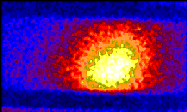 |  Shown is a false color image of Comet B2 Hyakutake observed with the Deep Survey Imaging Telescope of the Extreme Ultraviolet Explorer (EUVE) NASA satellite. Visible light can be seen through an optical telescope, however,
many types of light are "captured" or "detected" in different ways. One way is by having light pass through a metal or plastic foil filter which only lets a certain range of light through. For instance, the light that forms this image passed through a filter which only allows light with wavelengths in the range of 70-90 Angstroms to go through. 70-90 Angstroms are wavelengths of extreme ultraviolet light. Shown is a false color image of Comet B2 Hyakutake observed with the Deep Survey Imaging Telescope of the Extreme Ultraviolet Explorer (EUVE) NASA satellite. Visible light can be seen through an optical telescope, however,
many types of light are "captured" or "detected" in different ways. One way is by having light pass through a metal or plastic foil filter which only lets a certain range of light through. For instance, the light that forms this image passed through a filter which only allows light with wavelengths in the range of 70-90 Angstroms to go through. 70-90 Angstroms are wavelengths of extreme ultraviolet light. |
Extreme Ultraviolet image of the crescent Moon. 
| 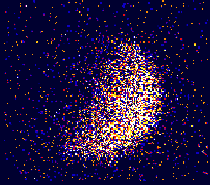 |
2. |
 |  Volcanic eruption on Io in visible light. Io is one of the moon's of Jupiter. Io was discovered by the scientists Galileo and Marius in 1610 (more than 300 years ago!) However, more moons around Jupiter have been discovered since 1610; some of them discovered only a short time ago. Volcanic eruption on Io in visible light. Io is one of the moon's of Jupiter. Io was discovered by the scientists Galileo and Marius in 1610 (more than 300 years ago!) However, more moons around Jupiter have been discovered since 1610; some of them discovered only a short time ago. |
This image was taken by the Hubble Space telescope.  It is a true color composite (visible light) of the full disk of Jupiter. All features of this image are cloud formations in the Jovian atmosphere, which contain small crystals of frozen ammonia and traces of colorful compounds of carbon, sulfur and phosphorous. It is a true color composite (visible light) of the full disk of Jupiter. All features of this image are cloud formations in the Jovian atmosphere, which contain small crystals of frozen ammonia and traces of colorful compounds of carbon, sulfur and phosphorous. |  |
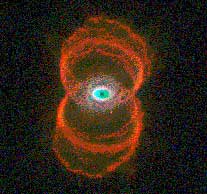 |
 Hourglass nebula around a dying star. This is a visible light image of MyCn18 - a planetary nebula located about 8,000 light years away from Earth. Hourglass nebula around a dying star. This is a visible light image of MyCn18 - a planetary nebula located about 8,000 light years away from Earth. |
 |  This is one of the nearest regions (to our solar system) of very recent star formation (300,000 years ago). The nebula is a giant gas cloud illuminated by the brightest of the young hot stars at the top of this visible light picture. This is one of the nearest regions (to our solar system) of very recent star formation (300,000 years ago). The nebula is a giant gas cloud illuminated by the brightest of the young hot stars at the top of this visible light picture. |
3. |
X-ray image of the Crab Nebula supernova remnant with the pulsar off (left) and on (right).  |  |
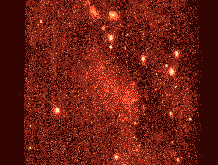 |  X-ray image of the center region of our Galaxy. X-ray image of the center region of our Galaxy. |
4. |
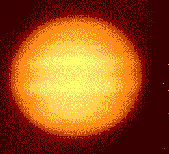 |  NASA Infrared Telescope Facility. Image of heat radiation from Jupiter. NASA Infrared Telescope Facility. Image of heat radiation from Jupiter. |
 Two infrared images of a volcanic eruption on Io - one of Jupiter's moons. The second image, taken seven days after the first image, reveals that the eruption has decreased in intensity. Two infrared images of a volcanic eruption on Io - one of Jupiter's moons. The second image, taken seven days after the first image, reveals that the eruption has decreased in intensity. |
 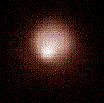 |
5. |
 |  Shown is a gamma ray image of the Orion molecular cloud complex. Shown is a gamma ray image of the Orion molecular cloud complex. |
Gamma ray image showing Geminga (above and left of
center) and the Crab nebula, two bright sources
of gamma rays.
 |  |
6. |
 |  This image shows microwave background radiation which is a remnant of the Big Bang origin of the Universe. This image shows microwave background radiation which is a remnant of the Big Bang origin of the Universe. |
7. |
 |  Radio wave image showing the Extra-galactic Radio Source Cygnus A Radio wave image showing the Extra-galactic Radio Source Cygnus A |
The Supernova Remnant Cas A (Radio wave image).
 | 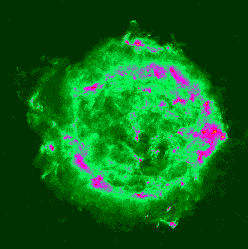 |
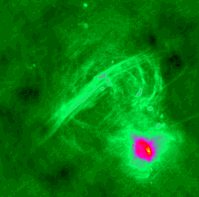 |  Radio wave image showing the Arc at the Galactic Center. Radio wave image showing the Arc at the Galactic Center. |
8. |
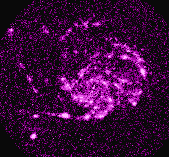 |  Shown is an ultraviolet image of the spiral galaxy M101, showing giant star formation regions (bright areas). Shown is an ultraviolet image of the spiral galaxy M101, showing giant star formation regions (bright areas). |
This image shows an ultraviolet image of the spiral galaxy NGC 4736 on top with av visible light image on the bottom 
|  |
 |  This is an old (evolved) supernova remnant in the constellation of Cygnus the Swan. The Cygnus Loop (also called the "Veil Nebula") is believed to be the remains of a star which went supernova (exploded) about 150,000 years ago. The original gaseous matter ejected when the star exploded has rammed into surrounding interstellar matter, which is now visible as broken, wispy, nebulous rings. This is an old (evolved) supernova remnant in the constellation of Cygnus the Swan. The Cygnus Loop (also called the "Veil Nebula") is believed to be the remains of a star which went supernova (exploded) about 150,000 years ago. The original gaseous matter ejected when the star exploded has rammed into surrounding interstellar matter, which is now visible as broken, wispy, nebulous rings. |

